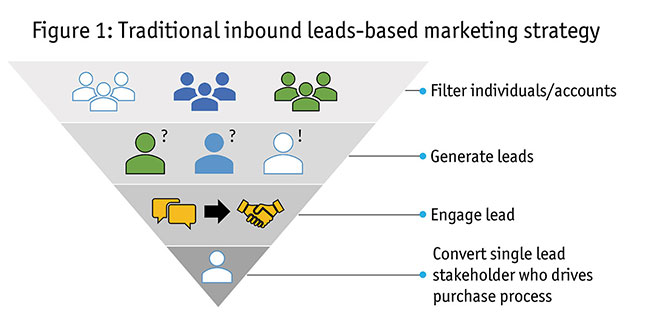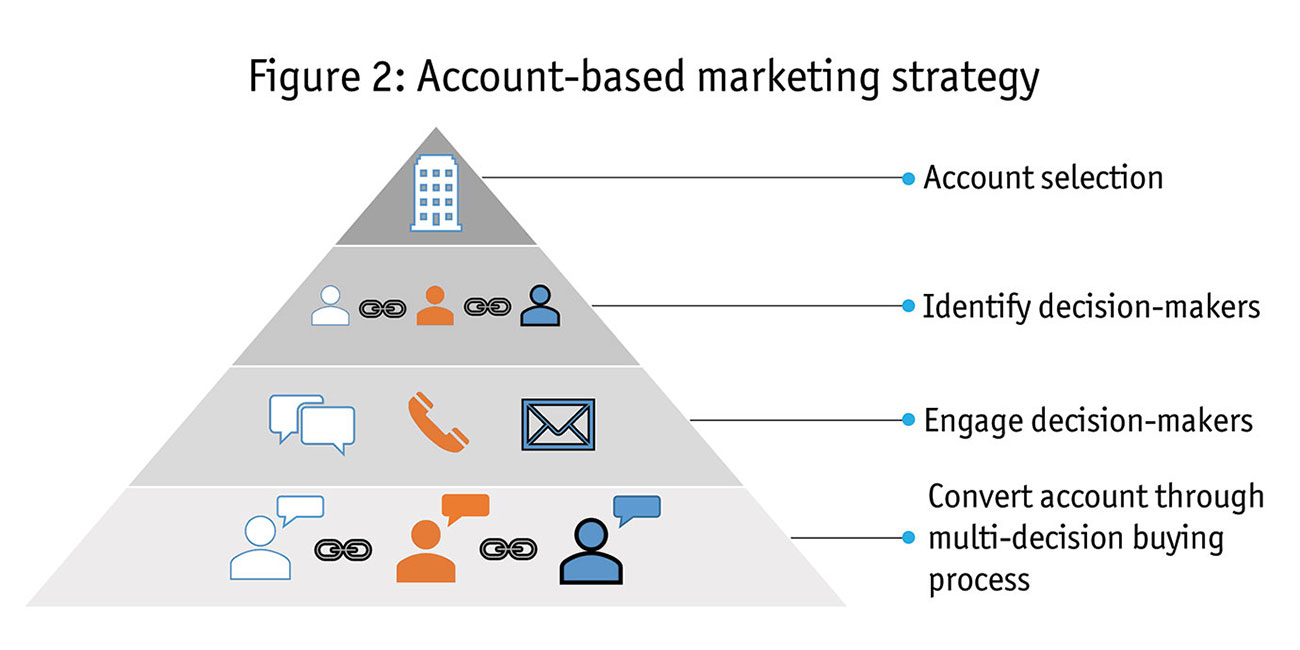Divide to conquer
Editor's note: Chris Claeys is senior director analytics and consulting at KJT Group Inc., a Honeoye Falls, N.Y., research firm.
 When conducting segmentation research, we tend to generalize the experience to one with a focus on understanding prototypes of individuals within the marketplace. This generalization is useful because it supports the traditional inbound leads-based marketing strategy (Figure 1) that most clients utilize as part of their marketing program. In principle, segmentation research of this kind helps throughout several critical layers of the marketing program (account selection, lead generation and lead engagement). However, for non-traditional marketing programs this characterization of segmentation is less useful. In essence, the way we conduct the research is no longer supportive of the client’s sales and marketing strategy. For instance, when thinking about multifaceted purchasing chains like hospitals or clinics (primarily a business-to-business concern), a segmentation model centered on individuals is decidedly less useful as it fails to address the perspectives of all relevant stakeholders (pharmacy directors, clinicians, C-suite, etc.); the entire engagement function is no longer supported by the segmentation research.
When conducting segmentation research, we tend to generalize the experience to one with a focus on understanding prototypes of individuals within the marketplace. This generalization is useful because it supports the traditional inbound leads-based marketing strategy (Figure 1) that most clients utilize as part of their marketing program. In principle, segmentation research of this kind helps throughout several critical layers of the marketing program (account selection, lead generation and lead engagement). However, for non-traditional marketing programs this characterization of segmentation is less useful. In essence, the way we conduct the research is no longer supportive of the client’s sales and marketing strategy. For instance, when thinking about multifaceted purchasing chains like hospitals or clinics (primarily a business-to-business concern), a segmentation model centered on individuals is decidedly less useful as it fails to address the perspectives of all relevant stakeholders (pharmacy directors, clinicians, C-suite, etc.); the entire engagement function is no longer supported by the segmentation research.

One alternative to the standard individual-based approach is an account-based segmentation model where the objective focus is to discover heterogenous groups of homogenous accounts in the market. At a high level this objective isn’t entirely different from the individual-based approach; however, it requires an approach to and application of the research that is almost entirely reversed (Figure 2). We’re required to identify and focus on key accounts, decision makers and market dynamics from the outset of the research instead of uncovering them as part of the research.
In the health care market both approaches are necessary and share a degree of overlap that can be useful when creating procedural standards. We’ll explore each in more depth to highlight the areas of overlap and, more importantly, the areas of differentiation.

Individual-based segmentation
Individual-based segmentation research largely encompasses the research process typified by what we, as market researchers, refer to as segmentation. Our client needs a deeper understanding of the personas that exist within their market, how to communicate with these personas and what messages will be most impactful for each persona. These needs arise from the marketing function within our client’s organization and closely map to several critical layers of their marketing strategy. Therefore, the primary outcome of the market research isn’t a segmentation model but more precisely a segmentation model that can strategically support the endeavors of the marketing strategy. So, the research objectives are:
- identify key segments of opportunity in the market based on some predefined objective criteria (e.g., likelihood to purchase the client’s product, receptivity to key differentiators of the client’s product);
- profile key segments with actionable demographics, behaviors and attitudes to develop targeted impactful messaging; and
- identify the most appropriate marketing channels to reach key segments.
To deliver on these objectives we identify the most appropriate segmentation methodology (attitudinal, behavioral, needs-based, values and lifestyle, demographic or preference-based), develop a survey instrument geared towards the selected methodology (as well as the objective criteria), survey the appropriate demographic and then construct the segmentation model. This entire process is retroactively focused on the individual – the individual and their subsequent persona is studied as an outcome of the research, not as a consideration for the design of the research. Breaking this process down more explicitly, we trace the process and necessary outcomes of the research back to the client’s marketing strategy. The stated objectives of the research aren’t the determining factor of the research design and process.
Within the health care market this type of segmentation research is engendered by marketing strategies that are focused on reaching physicians, patients or both physicians and patients with respect to, in most cases, pharmaceutical products. This application is logical – physicians have their own attitudes and behaviors, related to prescription medications, that determine how they’ll respond to various treatment options and, ultimately, what they’ll prescribe for a patient on any given office visit. Assuming our client doesn’t need to worry about formulary access or step edit restrictions, etc., the decision chain they need to consider is short and predominantly influenced by the physician. However, given the market, the patient may play just as important a role in the decision chain and so the marketing strategy (and subsequently the market research) may focus on their perspective as well. In both cases, the marketing strategy is operationalized around a business-to-consumer (B2C) sales paradigm for which an individual-based approach to segmentation is highly relevant. When the decision-chain can no longer be thought of as B2C, both the marketing strategy and the market research become less relevant and actionable.
Account-based segmentation
Account-based segmentation is thematically like that of an individual-based approach – our client needs a deeper understanding of the accounts that exist in the market, how best to communicate with these accounts and what messages will be most effective when communicating with them. These needs arise from the marketing function within our client’s organization and closely map to several critical layers of their marketing initiatives. However, the primary outcomes of the market research and the way it is designed are critically different. This is because, as previously discussed, the marketing strategy, not the research objectives, is the determinant of the research design and outcomes and when considering accounts, it is no longer reasonable to operationalize a marketing strategy around a B2C model. In most instances our clients will be utilizing a business-to-business model and will need a market segmentation that helps them transition from inbound marketing to account-based marketing. Consequently, the process needs to be reversed and proactively focused on the unit of analysis (the account) as in Figure 2. Operationally, we can then think of the research objectives as:
Design
- identify accounts for the research;
- identify key decision-making roles within these accounts;
- develop an understanding of the market dynamics that differentiate these accounts (i.e., accounts don’t strictly have “attitudes” or “behaviors” so how do these lower-level ideas result in account-level outcomes?).
Output
- identify key account segments in the market based on some predefined objective criteria (e.g., their place in the transitional market model, product-portfolio mapping);
- profile key account segments with actionable demographics and decision-maker attitudes to develop targeted messaging for each account based on the decision makers within the account; and
- identify the most appropriate marketing channels to reach decision makers within key account segments.
To deliver on these objectives we identify the most relevant segmentation methodology (as listed above), develop a survey instrument geared towards the selected methodology (as well as the objective criteria), survey the appropriate demographic and then construct the segmentation model. Again, this high-level process is no different than an individual-based segmentation; however, there is more nuance in what we would consider as a “relevant” segmentation methodology. Since attitudes and behaviors of individuals don’t constitute account-level outcomes it is important to reconsider the context in which we pose our questions, the questions themselves and the broader themes we’re attempting to measure with the research.
For most account-level work in the health care industry, it is useful to focus on institutional outcomes and metrics – the larger strategic goals an institution wants to achieve to optimize performance under increasing utilization of value-based reimbursement models. This focus would be further narrowed depending on the client’s product portfolio and marketing objectives but would, regardless, provide a direct link to the marketing engagement function that is critical for account selling. That is: what problem(s) is this account trying to solve and how can our products help them? Further, focusing the objective criteria on outcomes produces research that can be mapped to a three-horizons business model; which accounts are the best fit for our client’s core offerings, which are the best fit for adjacent offerings and which have advanced enough to be a good fit for transformational offerings? These kinds of considerations are principal for developing products in evolving markets and dovetail into purchase chain considerations that would commonly be part of an account-based marketing strategy. Once an institution’s predominant operating concerns are identified, a deeper understanding of how to sell into these accounts can be developed. When the decision chain, necessitated by our client’s marketing strategy, is more B2B-focused than B2C-, account-based segmentation leads to more relevant and actionable results for our clients.
Critical piece
While market segmentation is a critical piece of any marketing strategy, it can create more barriers than it removes if the way it’s conducted prevents an implementation that supports strategic business goals. The differences we’ve discussed between individual and account-based segmentation highlight the need to consider our clients’ marketing strategies when we design and conduct segmentation market research. Ultimately this research is only as good as its application; so, fully assessing, understanding and thinking through the implementation at the beginning will ensure a successful research engagement for both vendors and clients.
